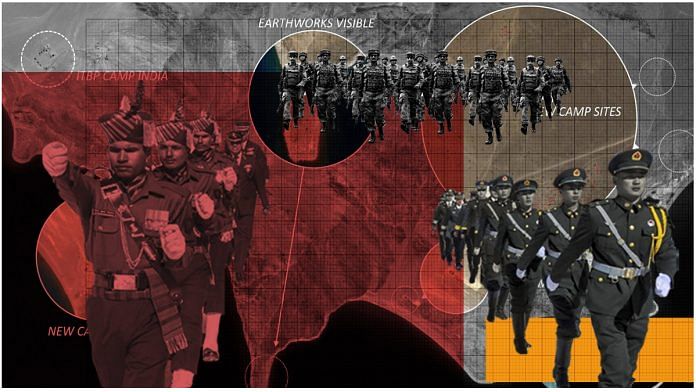New Delhi: The corps commanders from India and China are set to meet next week in Ladakh to carry forward the disengagement talks for the Pangong Lake and Depsang area. The meeting will also initiate steps for reduction in troop build-up along the Line of Actual Control (LAC), which includes tanks, artillery and additional forces in forward positions.
14 Corps commander Lieutenant General Harinder Singh and Major General Lin Liu, commander of the South Xinjiang Military District, will take stock of the first round of disengagement, which was completed from Patrol Point (PP) 17 in the Galwan Valley and the Hot Spring Area this Thursday.
“There are no Chinese soldiers now in the Indian side of the Galwan Valley, PP 15 and PP 17 and 17 A in the Hot Spring area. The Chinese have moved back by 1.5-2 km in these areas and are now across into their side of the LAC,” a source in the defence establishment said.
There will also be ground verification of the disengagement process by both sides to make sure the terms of the deal have been met.
Also read: Modi, Xi are strong leaders, but for lasting peace at the LAC both need to make compromises
WMCC meeting tomorrow
Sources said a meeting of the India-China Working Mechanism for Consultation & Coordination (WMCC) is likely to be held Friday. Following this, the agenda for next week’s corps commander-level talks will be decided.
“There will be a Corps Commander level meeting next week. The points of discussion will be refined based on the WMCC talks on Friday,” a source said
ThePrint had earlier reported that the WMCC meeting will take place virtually between Naveen Srivastava, joint secretary (East Asia), and Wu Jianghao, director general of the Department of Boundary & Oceanic Affairs, Chinese Ministry of Foreign Affairs.
As reported Monday, the disengagement process has been mutual so far, with India also pulling back from the contentious face-off points even though it was the Chinese that had intruded. This has resulted in China being closer to the Line of Actual Control than India.
India moved back a “little less” than China since the Army was anyway in their own territory, sources had said.
Also read: Military talks with the Chinese must not wear India down. Plan B should be ready
Terms of disengagement
The two sides have agreed that for now there will be no patrolling in the areas they pulled back from. Both have also agreed to maintain an equal number of camps and men at various distances from the earlier face-off point, though the Army remained tight-lipped on what the distance was and how many camps/soldiers were being allowed.
“This is not fixed. Let’s assume if the Chinese have to go back by 2 kms and India by 1 km, the tent can be placed only where there is space. It can’t be placed exactly where the 1 kms ends,” a source explained.
The source said that during the earlier Corps Commanders level talks — held on 22 and 30 June — the Chinese had claimed they were in the process of disengagement and the appearance of the Indian patrol team at their location on 15 June caused the delay. The quarrel over this was what had led to the violent face-off by the Shyok river, resulting in 20 soldiers being killed.
To avoid a repeat of such a situation, both sides have agreed to not carry out any patrolling for the time being.
India normally patrols up to PP 14 in Galwan Valley, and PP 15, 17 and 17A in the Hot Spring area.
There have, however, been inputs that the Chinese were challenging the patrolling of PP 11, 12 and 13 in the Depsang area by Indian soldiers.
Meanwhile, as reported Wednesday, China’s presence has “thinned down” at Finger 4 in the Pangong Lake area since the start of this week, though the People’s Liberation Army (PLA) continues to dominate the position.
In Depsang Plains, India and China have both increased deployment, though. The PLA deployed additional tanks and moved them slightly forward from their usual positions, but are still away from the LAC.
Also read: Sumdorong Chu, Ladakh-like India-China face-off which took 9 yrs to end but without violence



